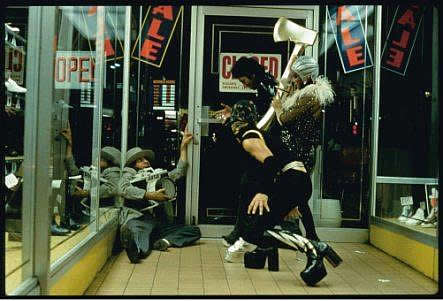Los Angeles County Museum of Art ,
Sep 04, 2011 - Dec 04, 2011
Los Angeles, CA, USA
Asco: Elite of the Obscure
by Mariola Alvarez
The exhibition, however, thoroughly demonstrated the distracted interests of Asco and their wide use of media to express their ideas, via such forms as performance art, photography, painting, graffiti, body art, sculpture, drawing, graphic design, mail art, and film. For example, included in the show was their early collaboration with the underground magazine Regeneración, published from 1970 to 1975, which was displayed in a traditional glass case with limited pages on view. Regardless, the presentation of the journal keenly emphasized the experimental nature of Asco, since it featured the political aspects of their project as a reaction to the Vietnam War and the violent and discriminatory treatment of Chicanos in Los Angeles from the very beginning of their practice together. The graphic design by the artists, mostly drawings, also demonstrated the influence of traditional Mexican art and Surrealism, but with their own inventive take that transformed the figures into absurd monstrosities in the case of Gamboa, Herrón and Gronk’s art, while Valdez experimented with a hybrid of photography, drawing and writing. Visible throughout the magazine and the exhibition more largely was Asco’s unique camp aesthetic that reveled in its outré taste derived from youthful exuberance, the glittering fashion of the seventies and a performative experience of Latino culture. Asco, which translates from Spanish as nausea or disgust, was performed by the group as a conceptual approach. One of the most amusing places where this attitude could be seen in the exhibition was the series No Movies, a collection of photographs that enact movies without film cameras. Once more Asco engaged with the city that gave birth to Hollywood, but in order to call out its exclusion of minorities and thus the absence on screens of Asco’s experiences and fantasies. So instead the artists re-imagined themselves as the directors, writers and screen stars in dramatic and witty style. Playful in flavor like the early punk films of Derek Jarman, No Movies tell stories without dialogue, instead they opt for using costuming and makeup, location, props and, especially, body gestures to create the spirit of the narrative. For Asco, the body operated as the site to attack the mainstream and their refusal of these same "brown" bodies in Hollywood and the fine art world. Asco used locations such as Los Angeles County Museum, Philippe’s Original Sandwich Shop and the Music Center in downtown L.A. as the sites of their art to make visible the geographical hierarchy of power of Los Angeles. The group’s work can be interpreted as marking the spaces of invisibility within cultural institutions; yet it also performed the impossibility of silence. No Movies for example presents the possibility of Chicano cinema, and even beyond ethnic identity markers, counter-cultural cinema, gay cinema, agitprop cinema, etc. Asco did not just point out their marginalization, but they created for their own pleasure the means to be the stars of their own shows. The exhibition re-affirmed this approach by presenting the costumes worn by Asco as if touring a Hollywood studio.
To return then to the Pacific Standard Time initiative, its objective was to canonize the history of the Los Angeles art scene which, as much of its press material makes clear, had been under-researched, overlooked, especially in comparison to the art production of New York artists, and even "in some cases in danger of being lost and destroyed." (1) The same could be said for the history of Asco and Chicano art, more largely, and in a cruel paradox, the threat of the loss of their story was a result of their absence from the major movements and exhibitions in L.A. that Pacific Standard Time now aims to celebrate. And though now with the exhibition Asco: Elite of the Obscure the group finds itself claimed by a double canon - Los Angeles art and Latino art - Asco’s art continued to rebel against the white walls of the LACMA galleries and refuses to be folded neatly into any one historical narrative.
NOTES:
1) Deborah Marrow, Director of the Getty Foundation, quoted in "Pacific Standard Time Opening Press Release," Presscenter.Pacificstandardtime.org, September 27, 2012
Mariola V. Alvarez holds a doctorate in art history from UC San Diego and has received a Mellon Post Doctoral Fellowship at Rice University for 2012-2014.
|













